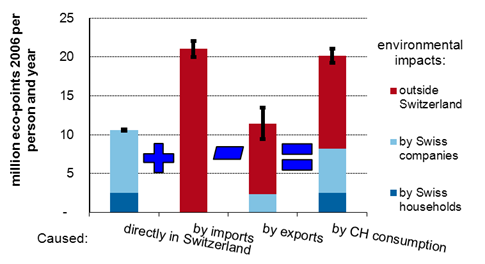A combination of input-output analysis with life cycle assessment
What are the environmental impacts of Swiss production and consumption patterns? Answering this question was the main topic of a project we did on an environmental extended input-output analysis together with Rütter+Partner.
Methodology
Environmental impacts of a country can be analysed from the production or the consumption perspective. The production perspective analyses the environmental impacts within the national boundaries. The consumption perspective includes life-cycle thinking and looks on goods and services consumed within the national boundaries. Thus, impacts caused during the production of imported goods are included while these of exported goods are subtracted from the total balance.
This research project investigated for the first time the total environmental impacts due to Swiss consumption and production with the ecological scarcity method. About 60% of environmental impacts that are caused by final demand occur abroad as a result of imported goods and services. The most important area of consumption is nutrition that accounts for about 30% of total impacts, followed by housing and mobility of private households. Within this study, input-output analysis and environmental data are combined in order to get a true and fair view on total environmental impacts of consumption and production.
The first LCA of Switzerland environmental impact also formed the basis e.g. for different personal footprint calculators and for the assessment of reduction potentials.
Basic data and results of the analysis are published in the EcoSpold format and available for SimaPro and other formats (download).
Project results were presented at a Swiss LCA discussion forum (DF 45), 15. September 2011, Berne-Ittigen.
Commissioner: Swiss Federal Office for the Environment (FOEN)
Overview of the environmental impacts of consumption and production in the Swiss national economy
In this diagram the environmental impacts in the year 2005 are assessed using the method of ecological scarcity. The average value of the two calculation approaches and the deviation between the two results are illustrated as the range. Imports make an important contribution to the total impacts from the Swiss final demand.
Presentation on the Organizational Carbon Footprint of the City Council of Zurich
At the Life Cycle Innovation Conference 2024 in Berlin, we gave an insight into our work on the Organizational Carbon Footprint of the City Council of Zurich. Here you can find the recording of the presentation.
Publications
Ulrich M., Jungbluth N. (2024) Organizational Carbon Footprint of the City Council of Zurich. ESU-services Ltd., Presentation at Life Cycle innovation conference in Berlin, 2024.
Jungbluth N., Nathani C., Stucki M., Leuenberger M. 2011: Environmental Impacts of Swiss Consumption and Production. A combination of input-output analysis with life cycle assessment. Federal Office for the Environment, Bern. Environmental studies no. 1111: 171 pp.
Jungbluth, N. 2011: Extending the IOA for investigating the environmental impacts of Swiss consumption and production. 45th LCA discussion forum, 15.9.2011 in Ittingen
Jungbluth, N. 2011: Environmental impacts of consumption and production in Switzerland: Environmentally extended input-output-analysis. 17th SETAC case studies symposium, 28.2.-1.3.2011 in Budapest
Jungbluth, N. 2010: Evaluating the importance of emissions and resource uses in the total environmental impacts caused by Swiss consumption. 40th LCA Discussion Forum: Developments in Impact Assessment Methods, with a Focus on 'Recipe' and on Abiotic Resources. April 2010, ETH Zürich
